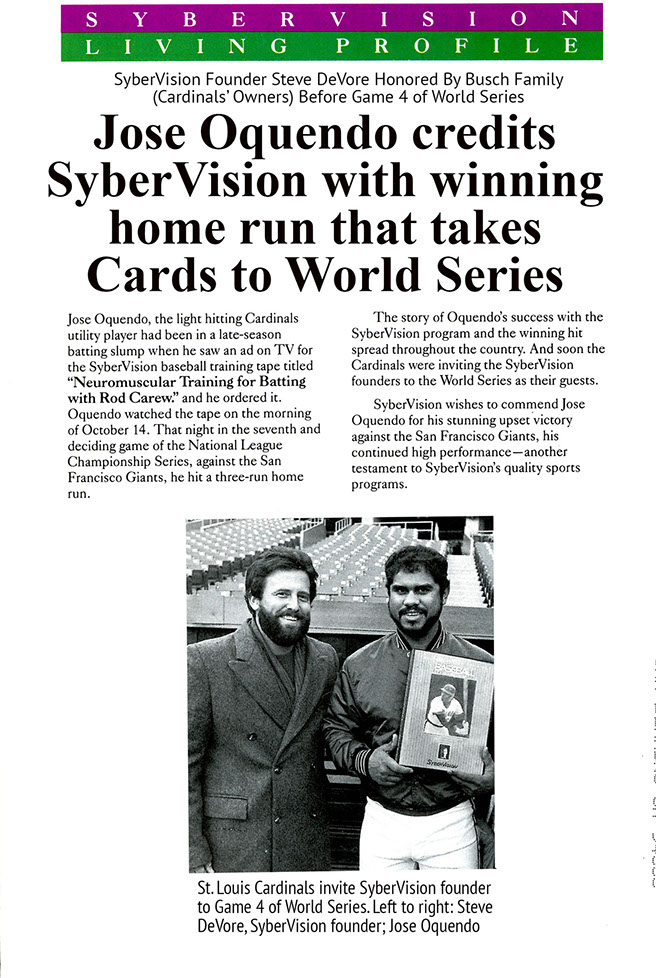What is Neuropsychology
BUDDY SYSTEM OFFER: BUY 1 PROGRAM GET 1 FREE FOR FRIEND
NOW WITH AUDIO TRANSCRIPTS PLUS SPECIAL LDS LIVING 50% DISCOUNT
What Do Faith, the Olympics, B1- Bombers, Japan's Largest Company & Gordon B. Hinckley Have to Do with Weight Control?
The New Neuropsychology of Weight Control:
The Result of an Advanced Learning &
Personal Achievement Technology
From Bowling to B1 Bombers
In 1972 Steve DeVore, founder of SyberVision, had just returned from his LDS Finnish mission and was attending BYU. One Saturday afternoon he and a friend were watching bowling on TV. As they watched Steve told his friend he had developed the ability to watch someone perform a specific skill and and then mimic the skill as perfectly as it was performed by the model.
Overcame the Crippling Effect of Polio By Watching & Mimicking Others
Steve with World Boxing Champion Max Baer at Children's Hospital, Oakland, 1953. Stevewas March of Dimes poster boy while recovering from polio.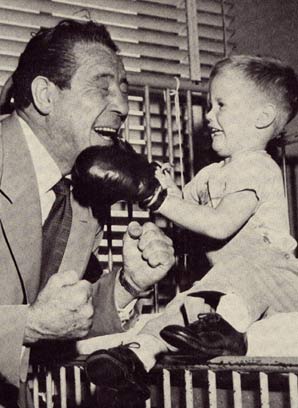 He explained to his friend that as a child he contracted polio and had to learn to walk again. He said he learned to walk by watching others and then mimicking their actions. Later, as he played sports he could do the same. When he watched a good basketball or baseball player he could perform for a short while at a high level.
He explained to his friend that as a child he contracted polio and had to learn to walk again. He said he learned to walk by watching others and then mimicking their actions. Later, as he played sports he could do the same. When he watched a good basketball or baseball player he could perform for a short while at a high level.
Bowls Almost a Perfect Game After Watching Bowlers on TelevisionFourteen years after Steve's bowling experience Marshall Holman, one of the greatest pro bowlers of all time, became the SyberVision model for bowling
Steve and his friend went to Regal Lanes in Provo. Steve bowled nine strikes in a row in his first game. The second game he bowled 8 strikes in a row. What was amazing the highest score he ever had in bowling was 163 and that was when he was 10 years old.
This phenomenon, the "modeling phenomena," fascinated Steve so much that he pursued it as a line of study that eventually led to his life's work.
Humans Learn Behavior & Skill From Role Models
What he learned was all human behavior is learned from role models. We observe people in our environ-
ment — how they act, what they believe, what skills they have— and we assimilate those behaviors.
This phenomenon is the basis of a science called social psychology. What social psychology couldn't explain is what happens in the brain to convert what we see other's do (role models) into what we do (behaviors and skills) .
How What We See and What We Imagine are Transformed By the Brain into Behavior & Skills
Steve found the answer at the Stanford University Neuropsychology Research Laboratory headed by the father of Karl Pribram, MD, PhD, father of neuropsychology, founder Stanford Neuropsychology Research Lab & Director of Research SyberVision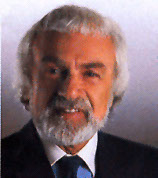 neuropsychology Dr. Karl Pribram, MD, PhD. Steve joined Dr. Pribram's research team and spent 8 years at Stanford researching his theory working with the Stanford School of Education, the Department of Athletics and the Stanford Medical School.
neuropsychology Dr. Karl Pribram, MD, PhD. Steve joined Dr. Pribram's research team and spent 8 years at Stanford researching his theory working with the Stanford School of Education, the Department of Athletics and the Stanford Medical School.
Mechanism in Brain Discovered. How Images are Transformed into Behavior
Steve learned there is a mechanism in the brain (mirror neurons) that converts what we see (both actual images and imagined images) into what we do. This mechanism follows a mathematical algorithm called the Fourier Transform to convert images into behavior and skills.
"Film-to-Brain" Technology Major Breakthrough in Sport Training
Steve developed a revolutionary sport training system called "Film-to-Brain." An athlete watching a specially edited film of themselves or a model performing perfectly (negative performance edited out and positive performance presented repetitively) would experience the equivalent of hours of perfect practice.
The editing formula (number of repetitions, camera angles, film speed, frames per second) was based on the Film-to-Brain editing formula conforms to Fourier Transform algorithm to create nervous system equivalent of hours of perfect
physical practice.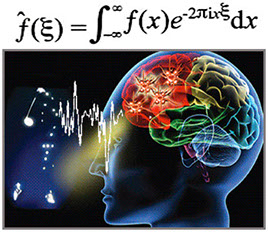 parameters of the Fourier Transform. As each modeled skill came in to the brain through the eyes, the brain transformed the images into impulses that repetitively stimulated and positively reinforced the muscles involved in the action in nearly the same way that perfect repetitive physical practice would.
parameters of the Fourier Transform. As each modeled skill came in to the brain through the eyes, the brain transformed the images into impulses that repetitively stimulated and positively reinforced the muscles involved in the action in nearly the same way that perfect repetitive physical practice would.
Dramatic Success in College Sports
Steve's system was tested and perfected with dramatic results with the Stanford and University of California Berkeley tennis, football, baseball, basketball and golf teams.
As word spread of Steve's phenomenal success professional football (San Diego Chargers, Dallas Cowboys, San Francisco 49ers, basketball (Milwaukee Bucks, Golden State Warriors) baseball (Oakland A's, Toronto Blue Jays, St. Louis Cardinals, Anaheim Angels, San Diego Padres) tennis (Chris Everet, Stan Smith) and golf teams/players became involved and achieved dramatic results with Steve's "Film-to-Brain" technology.
Professional Athletes & Teams, U.S. Olympics, Ski Resorts and Air Force Adopt "Film-to- Brain Technology
Many of the world's top athletes used and endorsed the system.
Steve's "Film-to-Brain" training system was adopted by and used to train U.S. Olympic athletes at the Colorado Springs, Colorado Olympic Sports Training Facility.
The world famous Vail ski resort and other major ski resorts around the world converted their entire ski schools to Steve's "Film-to-Brain" technology.
The U.S. Air Force even built a billion dollar B1 bomber flight crew training system using Steve's "Film-to-Brain" technology.
This knowledge of how the brain converts images of models into positive behaviors extended well beyond athletics in to other areas of life.
The New Neuropsychology of Weight Control has it's roots in and is the culmination of advanced research at two world-class universities: Stanford University (the Stanford Neuropsychology Research Laboratory/The Stanford School of Medicine) and Brigham Young University (the Human Performance Research Center).
The New Neuropsychology of Weight Control is based on a learning and achievement system pioneered by SyberVision founder Steve DeVore at the Stanford University Neuropsychology Research Laboratory.
The first step in the system is to identify high achieving people or models of success. In the case of weight control, we identified formerly overweight people who have been able to lose weight and permanently keep it off.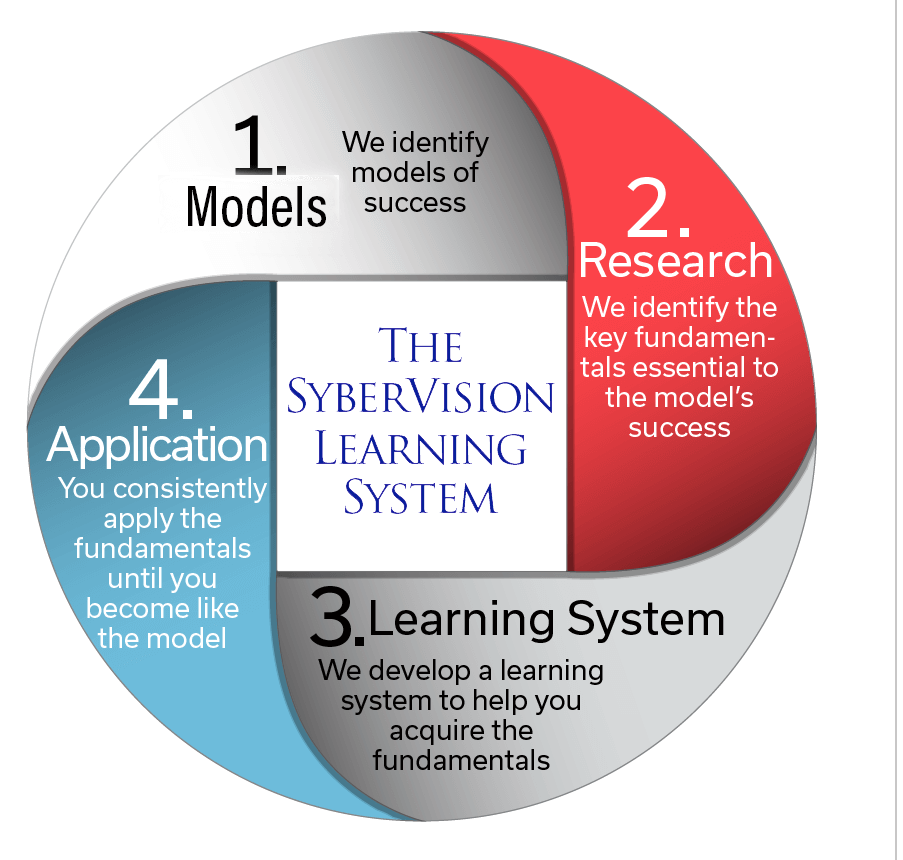 The second step is to research and analyze these people to determine the success characteristics and strategies they have in common and then construct a descriptive model of success made up of those characteristics — an ideal model we strive to emulate and become like.
The second step is to research and analyze these people to determine the success characteristics and strategies they have in common and then construct a descriptive model of success made up of those characteristics — an ideal model we strive to emulate and become like.
We then study the model to formulate a theory of achievement. In the case of weight control we came up with the concept of the "fat & psychological thermostat" which provided the explanation of why "white" foods and low-calorie dieting make us fat and why eating plenty of delicious, wholesome natural food makes and keeps us lean and healthy.
Third we develop a step-by-step learning system which allows us to acquire the characteristics of the model.
Fourth you learn how to develop the self-motivation necessary to consistently apply the principles of success until they become a habit. This effort takes time, steady application and patience.
The Image of Achievement = Temporal Faith
The driving force behind this motivation and discipline is something we call the "vision" This is an mental image of a ideal future state-of-being that currently doesn't exist but is desirable and achievable — an image we create and hold withing our imagination. The richer and more "substance" the vision has and the deeper our belief that we can achieve it provides the emotional forces necessary to sustain the long-term effort required to achieve it.
Vision (the substance of things hoped for but not seen) is the principle of and moving cause of all action in human achievement and gives us power to sustain a steady course of action (persist & persevere through hope) until the vision is achieved.
In neuropsychology (the study of how the brain influences behavior and how our behavior influences the brain) we call this vision the "image of achievement." Our Creator designed our brain to learn from and become like the models we choose to emulate. This image of achievement is the "programming" language of the brain. Whatever we imagine and hold in our imaginations the image of the model (or any goal) is ultimately expressed in behavior and in the outcomes or consequences of our behavior.
In the religious sense this concept is called temporal "faith." When the application of faith is directed at believing in and becoming like a religious model ( Christ, for example, in Christianity) this ideal "image of achievement" or faith becomes a spiritual principle. In the case of weight control, this power of Temporal faith is directed at becoming like the model of a lean, healthy and happy individual — acquiring its characteristics, attitudes, behaviors and habits.
How the SyberVision learning system was developed is a fascinating story. If you have the time to read it (see below) you'll see how all of this fits together.

Stanford Tennis: Two U.S. Olympics Vail Converts Ski SyberVision Takes
National Championships Choose SyberVision School to SyberVision Japan By Storm
Cardinals Win National League SyberVision Trains Students Use SyberVision
Championship with SyberVision B1 Bomber Pilots Russian to Meet Gorbachev


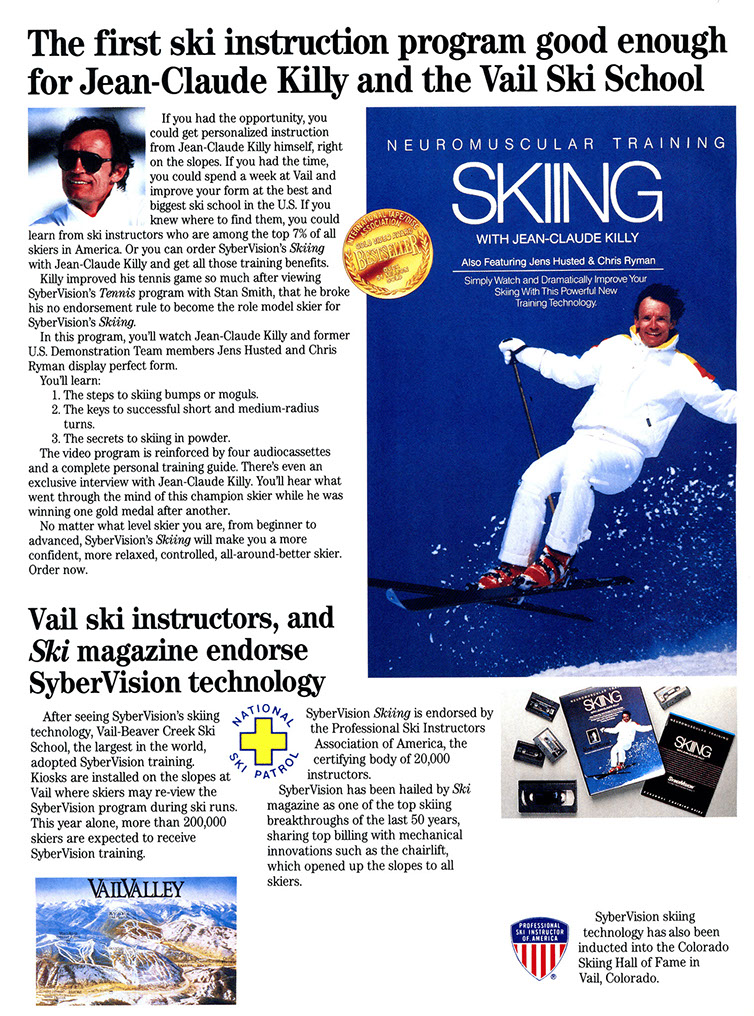


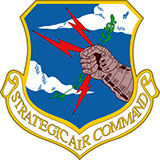 The SyberVision film-to-brain technology was also adopted by the U.S. Air Force's Strategic Air Command to train B1-1B bomber flight crews in high speed, low-level flight to coordinate, identify, respond to and evade an array of enemy anti-aircraft ordinance.
The SyberVision film-to-brain technology was also adopted by the U.S. Air Force's Strategic Air Command to train B1-1B bomber flight crews in high speed, low-level flight to coordinate, identify, respond to and evade an array of enemy anti-aircraft ordinance.
The B-1 is designed to penetrate a defensive network of radar, antiaircraft missiles and fighter planes by streaking through valleys and around hills at 650 miles an hour, which is nearly the speed of sound, at 200 feet above ground.
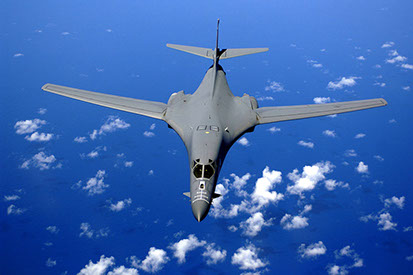 Flying a 400,000-pound aircraft at that speed so close to the ground where trees and water-towers flash by in a blur is among the most demanding tasks in aviation and requires not only careful initial training but constant refresher training for the crew of four.
Flying a 400,000-pound aircraft at that speed so close to the ground where trees and water-towers flash by in a blur is among the most demanding tasks in aviation and requires not only careful initial training but constant refresher training for the crew of four.
SyberVision founder Steve DeVore, doing "film-to-brain" research at Stanford University was contacted by the Stanford Research Institute (SRI) who was commissioned by military contractor GTE to develop a training program for the newly developed B1 bomber. GTE was competing with three other contractors for the Air Force contract.
GTE was competing with three other contractors for the Air Force contract.
DeVore received a top-secret clearance and spent two weeks at a top-secret facility outside of Boston where he learned about the new aircraft and interviewed flight crews to determine their needs.
He then designed a training technology that simulated dozens of defensive scenarios in which the flight crew had to identify incoming ordinance designed to destroy the plane and react as a team to avoid destruction.
Because of DeVore's design, GTE was awarded the $1 billion contract.
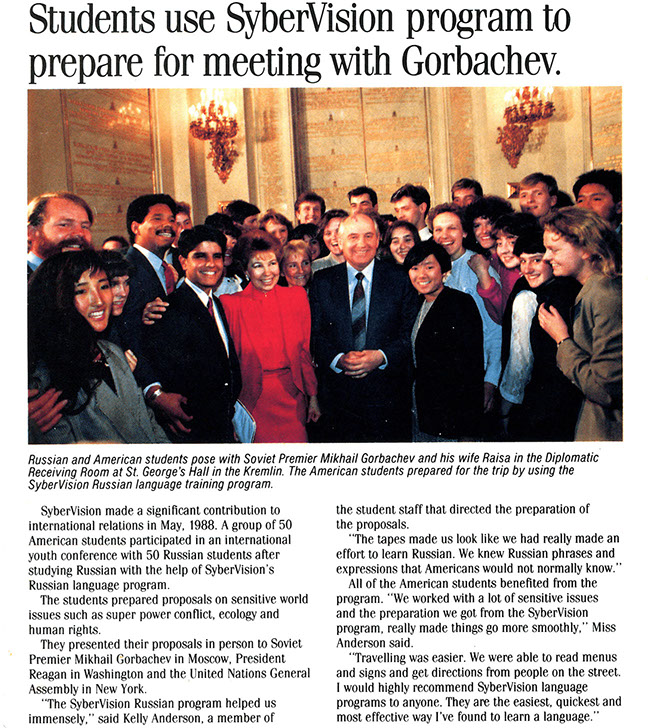
"Something I Created Killed Something I Loved"
"A lifelong San Francisco Giants fan deserves credit for Jose Oquendo's Game 7 home run that took the (hot) air out of the Giants and won the National League championship for the Cards.
"Seems Oquendo, who had been one for 10 before Wednesday's clincher, asked the estimable Kip Ingle of the Cardinals' public-relations office to help him get a videotape he had seen advertised on ESPN. The Sybervision "film-to-brain" training video' on hitting featured Rod Carew, who is Oquendo's idol, and it arrived in time for Oquendo to study it before Wednesday night's game.
"The rest is birds-on-the-bat history, and Giant agony for San Francisco loyalist Steve DeVore of Newark, Calif. DeVore is the founder of SyberVision Systems Inc., who developed the revolutionary "film-to-brain" technology. . "I can't believe it," DeVore said. "Something I created killed something I love." October 18, 1987 St. Louis Post Dispatch.
LDS Church Commissions Study of Greatness & Achievement For example, in 1992 the president of The Church of Jesus Christ of Latter-day Saints, Gordon B. Hinckley through its Bonneville affiliate commissioned Steve to do a study of history's greatest achievers in order to create a master model of human achievement. This study resulted in a 75-hour audio collection called The World's 100 Greatest People: The History of the World Through the Lives of Great Achievers written by Steve. The collection consisted of 100 45- to 60-minute audio biographies of each of the 100 historical figures selected. Steve then identified twelve characteristics these individuals had in common and developed a model of achievement and a system of how to acquire those desirable characteristics. Steve also created two other audio collections as part of this partnership: The World's 100 Greatest Books & The World's 50 Greatest Composers: The History of Classical Music.
For example, in 1992 the president of The Church of Jesus Christ of Latter-day Saints, Gordon B. Hinckley through its Bonneville affiliate commissioned Steve to do a study of history's greatest achievers in order to create a master model of human achievement. This study resulted in a 75-hour audio collection called The World's 100 Greatest People: The History of the World Through the Lives of Great Achievers written by Steve. The collection consisted of 100 45- to 60-minute audio biographies of each of the 100 historical figures selected. Steve then identified twelve characteristics these individuals had in common and developed a model of achievement and a system of how to acquire those desirable characteristics. Steve also created two other audio collections as part of this partnership: The World's 100 Greatest Books & The World's 50 Greatest Composers: The History of Classical Music.
Sixty-four Skill & Behavior Modeling Programs Developed
Some of the 64 modeling programs Steve developed (beside sports such as golf, tennis, skiing, baseball, racquetball, bowling, self-defense) included leadership, self-discipline, achievement, successful marriage, successful parenting, longevity, executive health, entrepreneurship, memory development, mastery of 55 foreign languages, and weight control. SyberVision's 32-page monthly catalog of Steve's programs was featured in the backseat of every American Airlines flight for five years. It was the precursor to SkyMall.
The Example of Weight Control
Steve, wife Kathy & 2 of their 21 grandchildren In the case of weight control, Steve teamed with Dr. Garth Fisher, founder and director of Brigham Young University's Human Performance Research Center. Dr. Fisher studied hundreds of overweight people who were able to lose weight and keep the weight off for the rest of their lives.
In the case of weight control, Steve teamed with Dr. Garth Fisher, founder and director of Brigham Young University's Human Performance Research Center. Dr. Fisher studied hundreds of overweight people who were able to lose weight and keep the weight off for the rest of their lives.
New BYU-Based Weight Control Program Sells 1.2 Million Copies
From this study Steve and Dr. Fisher were able to construct a theory of weight control (the "fat thermostat," the "psychological setpoint"), develop a model of the characteristics of those who were able to lose large amounts of weight and keep it off, and a system by which overweight people could assimilate the characteristics of the model to lose weight and keep it off for good. This weight control program, called The Neuropsychology of Weight Control sold over 1.2 million copies. Successful Weight Loss Customers Studied to New & More Refined Model of Weight Control Emerges
Successful Weight Loss Customers Studied to New & More Refined Model of Weight Control Emerges
Four years later Steve and Dr. Fisher interviewed and surveyed the 1.2 million users to determine what strategies the most successful weight losers (30 pounds and above) employed to be successful. This knowledge became the basis of an even more refined model of weight control success and became the focal point of The New Neuropsychology of Weight Control.
SyberVision Major Success But Victim of Hostile Takeover
Steve's company, SyberVision became very successful generating about $54 million a years in the sales of the personal achievement programs Steve wrote and developed. SyberVision was acquired by a large NYSE company called CML. CML came under attack by a corporate raider who wanted two of CML's companies Boston Whaler — a high quality recreational boat manufacturer — and Erickson Yachts.
After Two Different Owners Founder Finally Re-Acquires Company
In the prolonged battle (which made national headlines) Steve lost SyberVision and decided to leave the company due to differences in management philosophy. SyberVision went through two additional owners until Steve recently re-acquired SyberVision and some of the 64 intellectual properties (products) he developed. His language programs, for example, were sold by a previous owner to the mega-publisher Simon & Schuster for many millions of dollars and are now called The Pimsleur Foreign Language Learning System.
With the re-acquisition Steve published The New Neuropsychology of Weight Control. The program had been under development at the time of the takeover but not published. The New Neuropsychology of Weight Control was released in March of 2016.
Copyright © 2016 SyberVision Systems, Inc. All Rights Reserved
